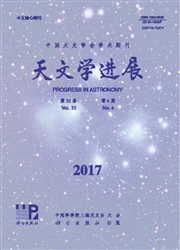

 中文摘要:
中文摘要:
褐矮星是亚恒星天体,内核没有稳定的氢燃烧,其质量一般在13至75倍木星质量之间。本质上,褐矮星的内核物理演化过程不同于行星和恒星,观测上我们根据褐矮星不同于行星和恒星的测光和光谱特征来区别证认它们。由于质量小、温度低,在光学波段,它们测光特征表现为光度暗,颜色红;在近红外波段,受大气尘埃、金属丰度等影响,它们有不同寻常的星等、颜色。根据褐矮星的光谱形态与特征谱线,它们可以被分为M、L、T和Y矮星。现在己发现的全部T与Y矮星都是褐矮星,但不是所有的M与L矮星都是褐矮星。介绍了L、T和Y矮星的特征吸收线和光谱分类方法,回顾了早期在星团和双星系统中褐矮星的搜寻,以及现阶段用大视场、长波段深度巡天数据在近邻场区中褐矮星的搜寻。对目前已发现的晚型M和L、T、Y矮星的总数目、温度范围、距离及测量其年龄的方法等做了小结。最后讨论了如何判断L矮星是否为褐矮星,重力、金属丰度和大气尘埃对近红外波段光谱形状的影响,光谱型-J波段绝对星等图上L、T交接处“大鼓包”的形成原因等热点问题。
 英文摘要:
英文摘要:
Brown dwarfs are substellar objects which have masses in between the most massive planets and the least massive stars. There are no stable hydrogen fusion in their interiors, although large mass brown dwarf might have instant hydrogen fusion in their core. All brown dwarfs have deuterium burning in their interiors. The L, T and Y dwarfs are cooler than M dwarfs. A small part of late M, most of the L, all of the T and all of the up to date discovered Y dwarfs are brown dwarfs. The hallmarks of L dwarfs in optical band are prominent absorption lines from neutral alkali atoms and alkali hydrides like KI, NaI, Fell etc. In near infrared band, the hallmarks of T dwarfs are strong HeO, CH4 absorption lines. The Y dwarfs have NH3 absorption lines in near infrared H band. The spectral type classification of these ultracool dwarfs are based on MK spectral classification system refering to the spectral indexes of the characteristic lines and the flux ratio that measuring the reddening. Given very low masses, brown dwarfs are faint and red in optical band, therefore not easy to be detected. In early days, scientists hunted for brown dwarfs in star clusters and binary systems where very few candidates were found. Thanks to the launch of deep sky surveys in optical and in NIR, recent years have seen a lot of discoveries of brown dwarfs. The L, T and Y dwarf candidates are selected according to their characteristic color. Briefly, L dwarfs have red(J-K 0.5-2.5) near infrared color, T dwarfs have blue(J-K 0.0-1.5) near infrared color, while the newly discovered Y dwarfs have WISE W1-W2 color exceeding - 4. Among these candidates, quite a lot were confirmed through the photometry and spectroscopy fellow up. Currently, more than 1200 ultracool dwarfs have been discovered. Methods for measuring their distances, temperatures, ages are summarized in this paper. Several related questions, e.g., how to judge whether a late-M or early-mid L dwarf is a brown dwarf or not, the origin of the J-band bump on the spectral type - ab
 同期刊论文项目
同期刊论文项目
 同项目期刊论文
同项目期刊论文
 COSMOLOGICAL EVOLUTION OF MASSIVE BLACK HOLES: EFFECTS OF EDDINGTON RATIO DISTRIBUTION AND QUASAR LI
COSMOLOGICAL EVOLUTION OF MASSIVE BLACK HOLES: EFFECTS OF EDDINGTON RATIO DISTRIBUTION AND QUASAR LI Influence of baryonic physics on the merger timescale of galaxies in N-body/hydrodynamical simulatio
Influence of baryonic physics on the merger timescale of galaxies in N-body/hydrodynamical simulatio SELF-CALIBRATION OF GRAVITATIONAL SHEAR-GALAXY INTRINSIC ELLIPTICITY CORRELATION IN WEAK LENSING SUR
SELF-CALIBRATION OF GRAVITATIONAL SHEAR-GALAXY INTRINSIC ELLIPTICITY CORRELATION IN WEAK LENSING SUR Exact analytical solution of the linear structure growth rate in Lambda CDM cosmology and its cosmol
Exact analytical solution of the linear structure growth rate in Lambda CDM cosmology and its cosmol The kinetic power of jets magnetically accelerated from advection-dominated accretion flows in radio
The kinetic power of jets magnetically accelerated from advection-dominated accretion flows in radio First measurement of Mg isotope abundances at high redshifts and accurate estimate of Delta alpha/al
First measurement of Mg isotope abundances at high redshifts and accurate estimate of Delta alpha/al Detecting the intrinsic Baldwin Effect of the optical FeII complex in luminous Seyfert 1 galaxy fair
Detecting the intrinsic Baldwin Effect of the optical FeII complex in luminous Seyfert 1 galaxy fair INTRINSIC ELLIPTICITY CORRELATION OF SDSS LUMINOUS RED GALAXIES AND MISALIGNMENT WITH THEIR HOST DAR
INTRINSIC ELLIPTICITY CORRELATION OF SDSS LUMINOUS RED GALAXIES AND MISALIGNMENT WITH THEIR HOST DAR THE GRAVITATIONAL SHEAR-INTRINSIC ELLIPTICITY CORRELATION FUNCTIONS OF LUMINOUS RED GALAXIES IN OBSE
THE GRAVITATIONAL SHEAR-INTRINSIC ELLIPTICITY CORRELATION FUNCTIONS OF LUMINOUS RED GALAXIES IN OBSE Imprint of the interaction between dark sectors in large scale cosmic microwave background anisotrop
Imprint of the interaction between dark sectors in large scale cosmic microwave background anisotrop IMAGES OF THE RADIATIVELY INEFFICIENT ACCRETION FLOW SURROUNDING A KERR BLACK HOLE: APPLICATION IN S
IMAGES OF THE RADIATIVELY INEFFICIENT ACCRETION FLOW SURROUNDING A KERR BLACK HOLE: APPLICATION IN S THE VELOCITY FUNCTION IN THE LOCAL ENVIRONMENT FROM Lambda CDM AND Lambda WDM CONSTRAINED SIMULATION
THE VELOCITY FUNCTION IN THE LOCAL ENVIRONMENT FROM Lambda CDM AND Lambda WDM CONSTRAINED SIMULATION Environmental effects on satellite galaxies: the link between concentration, size and colour profile
Environmental effects on satellite galaxies: the link between concentration, size and colour profile EVIDENCE FOR X-RAY SYNCHROTRON EMISSION FROM SIMULTANEOUS MID-INFRARED TO X-RAY OBSERVATIONS OF A ST
EVIDENCE FOR X-RAY SYNCHROTRON EMISSION FROM SIMULTANEOUS MID-INFRARED TO X-RAY OBSERVATIONS OF A ST Modeling Nonlinear Evolution of Baryon Acoustic Oscillations: Convergence Regime of N-body Simulatio
Modeling Nonlinear Evolution of Baryon Acoustic Oscillations: Convergence Regime of N-body Simulatio Confirmation of the Copernican Principle at Gpc Radial Scale and above from the Kinetic Sunyaev-Zel'
Confirmation of the Copernican Principle at Gpc Radial Scale and above from the Kinetic Sunyaev-Zel' The anticorrelation between the hard X-ray photon index and the Eddington ratio in low-luminosity ac
The anticorrelation between the hard X-ray photon index and the Eddington ratio in low-luminosity ac The mass profile of early-type galaxies in overdense environments: the case of the double source-pla
The mass profile of early-type galaxies in overdense environments: the case of the double source-pla Multi-Wavelength Study of a Complete IRAC 3.6micron-Selected Galaxy Sample: a Fair Census of Red and
Multi-Wavelength Study of a Complete IRAC 3.6micron-Selected Galaxy Sample: a Fair Census of Red and New Estimates of the Inclination, Position Angle, Pitch Angle, and Scale Height of the Whirlpool Gal
New Estimates of the Inclination, Position Angle, Pitch Angle, and Scale Height of the Whirlpool Gal Bayesian galaxy shape measurement for weak lensing surveys - III. Application to the Canada-France-H
Bayesian galaxy shape measurement for weak lensing surveys - III. Application to the Canada-France-H The ACS Fornax Cluster Survey. X. Color Gradients of Globular Cluster Systems in Early-type Galaxies
The ACS Fornax Cluster Survey. X. Color Gradients of Globular Cluster Systems in Early-type Galaxies 期刊信息
期刊信息
